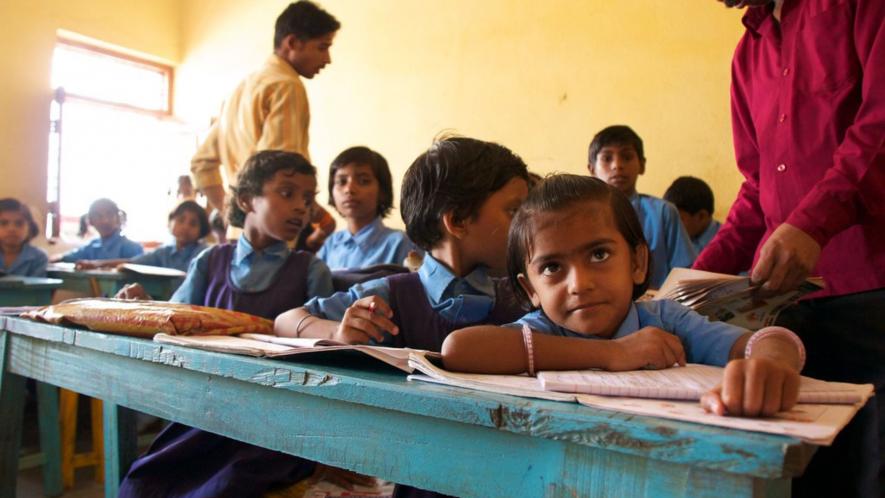Why Education Must Oil Wheels of Change in Bihar

Image Courtesy: Flickr
When we briefly met at Nalanda in Bihar in 2011, the Nobel laureate economist Amartya Sen reminisced about his childhood visit to the site of the ancient centre of learning in present-day Bihar. “My grandfather, Kshiti Mohan Sen, first brought me to this ancient seat of learning when I was ten years old,” Sen told me. Sen was then the chairperson of the governing board of the upcoming Nalanda University.
But even as he recalled his childhood visit, perhaps when India was on the cusp of freedom, something else had struck a stronger chord within him—another no less revolutionary change in the present. With a spark in his eyes, Sen shared his observation: “Today, it is so delightful to see girls in rural Bihar riding to school on their bicycles.”
The eminent economist and philosopher was referring to the bicycles, many of them gifts from the state government so that young girls in the hinterlands of Bihar could go to schools. To Sen, it was clear that these bicycles would be the “wheels of change” in Bihar.
Apart from the youngsters and their families, the credit for the cycling girls goes to Bihar Chief Minister Nitish Kumar, who zeroed in on primary education, especially in rural areas, as the key to uplift. Indeed, Bihar was woefully short of schools and teachers for decades. This writer recalls passing out from school in 1976 from the Dronacharya High School in the Siwan district—it did not have a single female student.
Successive state governments did not prioritise school education, especially in the rural areas. Change began slowly but surely in 2005, when Nitish, an engineer by training, became chief minister and introduced the cycle scheme, initially for female students only. The state government introduced similar schemes for uniforms and appointed thousands of teachers in later years.
Rural Bihar’s schools primarily operated without buildings in the open air or the shade of trees in the past. A mega exercise to construct school buildings, particularly in villages, began. The mid-day-meal scheme, introduced by the central government’s school education department to encourage students from underprivileged backgrounds to attend school, was pursued more seriously.
Today, Bihar has over 76,000 schools. According to UDISE reports for 2020-21, the number of government-run schools in Bihar has been increasing, unlike states like Uttar Pradesh and elsewhere, where there has been a decline due to merger, de-merger or closure of schools. Over 70% of Bihar’s schools now have concrete buildings.
Between 2008 and 2010, seeing female students go to schools in uniforms was a unique occurrence—even a spectacle. Today, it is commonplace in the morning and afternoon. Over roughly 12 years, the state’s schools have reached a 50-50 ratio of male to female students. The dropout rate has drastically fallen.
Employment Potential
There is a reason to recall these developments of the last decade today. The newly-formed INDIA, or Indian National Developmental Inclusive Alliance, has been setting its political agenda around food security, health care, education, employment and livelihood issues. Against this, the Bhartiya Janata Party has focused repeatedly on its Hindutva ideological project. However, the experiences in Bihar would establish why quality public education and other essential services remain a key demand and expectation of voters nationwide.
Bihar has chosen the education sector as the central area of priority to follow up on the recent caste survey report, which has thrown empirical data about poverty and backwardness in various strata of the society.
In February, the first budget of the Bihar government after Nitish parted ways with the BJP-led alliance, made the highest allocation for education (total outlay of Rs 40,450 crore), followed by health, road transport and social welfare sector.
The allocation is a nod to the growing demand for quality education, which is also linked with employment—and ‘employability’. Quality education is increasingly crucial in Bihar, Uttar Pradesh, Madhya Pradesh and Rajasthan, which are net contributors to the migrant workforce.
Unlike the BJP, which repeatedly raises emotive issues, the Bihar government focused on bread-and-butter concerns such as distributing 1.20 lakh letters of appointment to teachers earlier this month. These teachers were recruited through a competitive examination conducted by the Bihar Public Service Commission, which serves to reassure the public about the quality of teachers being inducted.
The state government has been developing the proper mechanisms to improve the education system. The education minister of Bihar is the RJD’s Dr Chandra Shekhar, a professor and educator. The additional chief secretary of the Department of Education, KK Pathak, has been tasked with regularly inspecting rural schools personally. (Surprise inspections are a classical way to create a sense of alertness among teachers and students.)
The ruling Janata Dal (United), Rashtriya Janata Dal, Congress, and Left Grand Alliance has also implemented a 75% quota for the Extremely Backward Classes (EBCs), Other Backward Classes (OBCs), Scheduled Castes (SCs), Scheduled Tribes (STs) and Economically Poor Classes (EPS), setting a template for the INDIA bloc in other states and at the national level.
Indeed, the INDIA alliance has others focusing on education, including the Aam Aadmi Party (AAP) government’s former education minister, Manish Sisodia, who is imprisoned as the Enforcement Directorate pursues a legal case against him. The AAP government is one of the few to focus on public education and healthcare in terms of rhetoric and action. Bihar deserves a little credit. After all, it has worked from scratch in the education sector, even in an era of religious politics entering the curriculum and classroom.
Limitations
Education is in the Concurrent List of the Constitution, which means the Centre and states share power and responsibilities on the subject. The state has two central universities—Mahatma Gandhi Central University, Motihari and the Central University of South Bihar, Bodhgaya. Allegations abound that the BJP has been on a spree to fill these universities with the Rashtriya Swayamsevak Sangh (RSS) cadres and supporters.
It is well known that Amartya Sen and George Yeo quit Nalanda University—one of only two universities under the aegis of the Ministry of External Affairs—after the Narendra Modi-led BJP came to power, citing “political interference”. Currently, Nalanda University has economist and Padma Bhushan awardee Arvind Panagariya and Abhay Kumar Singh, historian, as its chancellor and interim vice-chancellor.
Besides, the Governor, appointed by the central government, is a chancellor of state universities, but local newspapers invariably publish reports about the Governor working at variance with the state government and its education department. There is an unnecessary tussle over authority and jurisdiction in matters regarding the functioning of universities in the state.
Of course, Bihar has other limitations—as the recent caste survey reveals, universities lack experts and faculty crucial to equality education. The gross enrolment ratio in Bihar also dips significantly at the higher secondary level. As a result, not only do students migrate to the national capital or other cities for higher education in the sciences, engineering, medicine and humanities, the lack of educational attainment beyond secondary schooling becomes an impediment in student achievement.
The author is a senior journalist, media educator, and researcher in folklore. The views are personal.
Get the latest reports & analysis with people's perspective on Protests, movements & deep analytical videos, discussions of the current affairs in your Telegram app. Subscribe to NewsClick's Telegram channel & get Real-Time updates on stories, as they get published on our website.






















